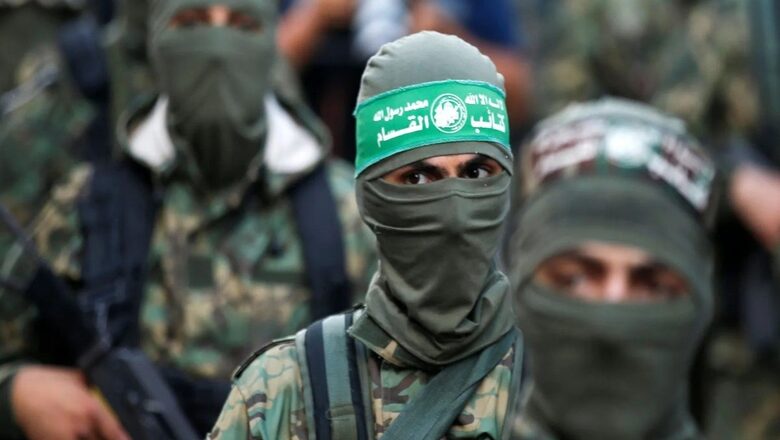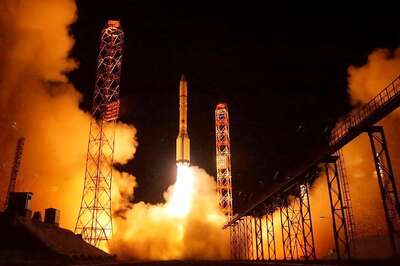
views
“Khaybar, Khaybar Ya Yehud, jaysh Muhammad Sawf Ya’ud” was a slogan coined by Sheikh Ahmed Ismail Hasan Yasin (1937-2004) during the tumultuous days of the first Palestinian Intifada when he founded Harakat al-Muqawama al-Islamiyya, cryptically known as Hamas, on December 14, 1987. The slogan means “Khaybar, Khaybar, O Jews, the army of Muhammad will return”. It is an obvious reference to the Battle of Khaybar between the early Muslims led by the Arabian Prophet and the Jews in 628 AD where the latter were defeated.
Despite being a wheel-chair bound quadriplegic for decades, and nearly blind, the Sheikh was never found lacking in Islamist enthusiasm to wreak havoc on Israel. He was killed in an Israeli helicopter gunshot in 2004, the same year that Yasir Arafat passed away later, of natural causes.
Yasir Arafat (1929-2004), the founder of Fatah, the largest constituent of the Palestinian Liberation Organisation, was the tallest Palestinian leader of all time. In India, in the 1980s and 90s, Palestine was Arafat and Arafat was Palestine. He later became the President of the Palestinian Authority, a position now held by his protégé, Mahmoud Abbas alias Abu Mazen. Yet, ironically, the legacy of Sheikh Ahmed Yasin has eclipsed the bequest of Yasir Arafat. If the statements by Mahmoud Abbas and Mustafa Barghouti (a Palestinian legislator popular on Indian television channels) on the recent massacre are a pointer, then Fatah has completely surrendered to the Islamist agenda of Hamas.
Yasir Arafat, notwithstanding his Nobel Prize for Peace in 1994, was not remotely a peacenik. He remained an inveterate enemy of Israel until his last days. He instigated the second Palestinian Intifada (2000-2005), which officially ended only after his death. However, it must be understood why Hamas chose to disagree with the Palestinian Liberation Organisation, at a time when the latter was synonymous with Palestine.
The Hamas Covenant, 1988 makes it abundantly clear that Islam is its central inspiration. Article 8 leaves little to the imagination, “Allah is its target, the Prophet is its model, the Koran is the Constitution: Jihad is its path and death for the sake of Allah is the loftiest of its wishes.”
Article 27 explains why Hamas differs from the Palestinian Liberation Organisation (PLO). It says, “Secularism completely contradicts religious ideology. Attitudes, conduct and decisions stem from ideologies. That is why, with all our appreciation for The Palestinian Liberation Organization – and what it can develop into- and without belittling its role in the Arab-Israeli conflict, we are unable to exchange the present or future Islamic Palestine with the secular idea. The Islamic nature of Palestine is part of our religion and whoever takes his religion lightly is a loser. The day The Palestinian Liberation Organization adopts Islam as its way of life, we will become its soldiers, and the fuel for its fire that will burn the enemies.”
Hamas identifies itself as a wing of the Muslim Brotherhood, founded in 1928 by Hassan al-Banna (1906-1949) of Egypt. The Covenant says, in quoting al-Banna, “Israel will exist and will continue to exist until Islam will obliterate it, just as it obliterated others before it.”
However, if one pores over the seven points passed by the central committee of Al-Fatah (1969), one finds under Point 2-Al Fatah, the Palestine National Liberation Movement, is not struggling against the Jews as an ethnic and religious community. It is struggling against Israel as an expression of colonisation based on a theocratic, racist and expansionist system of Zionism and colonialism. Under Point 5, it identifies its object as the restoration of the independent, democratic state of Palestine, all whose citizens will enjoy equal rights irrespective of their religion (The Israel Arab Reader by Walter Lacquer, P.444).
Al-Fatah was co-founded by Yasir Arafat, who called it a movement rather than an organisation, towards the end of the 1950s. From the very beginning, to quote historian S. Shamir Hassan, Al-Fatah emphasised on the military thrust of the movement, and the struggle carried out by its military arm. It proclaimed its foundation day on January 5, 1965, when it carried out its first military operation codenamed Al-Asifa or the Storm. Parrying the accusation that Al-Fatah enjoyed the support of conservative kingdoms like Saudi Arabia, Kuwait and Persian Gulf Principalities (UAE, Bahrain etc), Arafat said, “I am using Saudi money to buy weapons from China” (Al-Fatah – A study of Ideological Evolution, Proceedings of the Indian History Congress Vol.61, Part -2 Millennium 2000-01, P.1136).
However, it was not very successful in its military operations. Al-Fatah later joined the ranks of the Palestine Liberation Organisation, subsequently called Palestinian Liberation Organisation (PLO), founded on May 28, 1964, by Ahmed Shukairy, the Chairman of the First Palestine Congress. The original Charter of Palestine Liberation Organization (1964) does not cite Islam as a source of inspiration. It does not refer to the word Muslim even once, though it refers to Jews twice. Its Article 15 speaks about safeguarding all Holy places, and the guarantee of freedom to worship and visit for all, without discrimination of race, colour, language and religion.
It might still be argued that prior to June 1967, the West Bank and East Jerusalem were held by the Kingdom of Jordan, and Gaza by Egypt. Hence, which “Palestine” were the founders of Al-Fatah or the PLO trying to “liberate”? Naturally, by “Palestine” they meant sovereign territories of Israel. However, on the question of religion, the Fatah or the PLO claimed to be more progressive.
Yasir Arafat in addressing the United Nations General Assembly (UNGA) on November 13, 1974, as the Chairman of the Palestinian Liberation Organisation stated, “Therefore, since its inception, our revolution was not motivated by racial or religious factors. Its target was never the Jew, as a person, but racist Zionism, and undisguised aggression. We are struggling that Jews, Christians and Muslims may live in equality, enjoying the same rights, and assuming the same duties, free from racial and religious discrimination” (Palestine Lives, P.19).
It is true that scholars like Bernard Lewis discovered a striking Islamic factor in the imagery and symbolism of Fatah. For example, the PLO brigades were named after great victories won by Muslims in battles against non-Muslims viz. Qadisiya, Ifttin and Ayn Jahut. This, however, is an inherent characteristic of Islam. As Islam, since the lifetime of the Prophet, had advanced by a series of battles, any Muslim country or organisation in search of classical names for military brigades or campaigns will reach out to the 7th century BC.
II
Hamas, on the other hand, made no secret of its Islamist agenda from the very beginning. It did not rule out cooperation with Al-Fatah, a part of the PLO, but on the condition the PLO exchanged secularism for Islamism. The trend of Islamism gained ground in the Middle East after the Iranian Revolution. Arafat knew he had to appease the revivalist constituency if he wished the initiative to pass out from his hand to Sheikh Ahmed Yasin.
Hamas was not a party to the Oslo Accord, 1993 followed by the Gaza-Jericho Agreement, 1994 between the PLO and Israel. It has not recognised Israel’s inherent right to exist unlike Egypt, Jordan, PLO and UAE etc. Thus Hamas’ position on Israel is the same as espoused by Nasserite Egypt before the 1967 War — “Wipe out Israel from the face of the globe”. Whereas the other Arab states, though not reconciled to the existence of Israel, consider discretion as a better part of valour, Hamas still feel it can re-enact the 7th century AD in the 21st century AD. Thus while Arafat’s followers are no longer a deadly threat to Israel, Sheikh Yasin’s followers will continue to be a bugbear for Israel.
Interestingly, Hamas came out with a new Charter in 2017. It has tried to modernise the language as compared to the 1988 Covenant. It says that Hamas does not wage a struggle against the Jews, because they are Jewish, but wages a struggle against the Zionists who occupy Palestine. It has tried to project that the Jewish problem, anti-Semitism, and persecution of Jews are fundamentally linked to European history and not to the history of Arabs and Muslims to their heritage.
Hamas now wants to paper over the Battle of Khaybar (628 AD) against the Jews or the invasion of Banu Qurayza etc. It appears that the new Charter of Hamas is aimed at ending its international isolation, since 2007 when it forcibly occupied the Gaza Strip, after a factional war with Fatah.
III
Between August 15 and September 22, 2005, Israel withdrew completely from the Gaza Strip and adjacent northern Samaria. Around 9,000 Israeli citizens living in 25 settlements in Gaza were evicted against their wishes by the Ariel Sharon government. Within a few months, Sharon suffered a brain stroke in January 2006 from which he never recovered. In the same month, there were the first and only elections held to date for the Palestinian Authority, in which Hamas (running under the name “Change and Reform”) secured 74 seats in a 132-seat unicameral legislature, leaving Fatah a poor second with 45 seats.
Since President of the Palestinian Authority Mahmoud Abbas was from Fatah, it was thought that for the sake of concord, a Hamas-Fatah unity government would be formed. When the list of cabinet ministers was presented by Ismail Haniya on March 27, 2006, it only contained the names of Hamas representatives. The relationship between the two parties deteriorated sharply, leading to a civil war, which split the Palestinian Authority on regional lines. On June 14, 2007, Hamas conclusively established control over the Gaza Strip thus bringing the civil war to an end. Over the last 16 years, with no more elections, Hamas controls Gaza, whereas Fatah controls the West Bank. In the meanwhile, the Parliament building in Ramallah, West Bank has gone to the seeds.
While it was hoped that the Israeli withdrawal from Gaza would open up a window of peace in the post-Arafat era, Gaza soon became a nursery of terrorism under Hamas’ fiefdom. It began with Hamas seizing an Israeli soldier, Gilad Shalit, on June 26, 2006 — an ordeal that ended five years later in 2011 when he was exchanged for 1,027 prisoners. Gaza, teeming with 2.3 million people, lives a decrepit existence under Hamas’ rule. How the current round of hostage problems ends remains to be seen.
In the last decade and a half, Gaza has acted as a launching pad for several serious attacks on Israel like in 2009 and 2014 leading to major hostilities. The hostilities emanating from the West Bank have gone down over the decade and a half.
Hamas’ recent attack, which involved the slaughter of civilians, including women and children, is the deadliest. Are we to seriously believe that “Khaybar, Khaybar Ya Yehud, jaysh Muhammad Sawf Ya’ud” is no longer in the minds of its perpetrators? Does the PLO members’ silence on the Islamist inspiration of Hamas betray their fears of alienating Palestinian Arabs?
The writer is author of the book “The Microphone Men: How Orators Created a Modern India” (2019) and an independent researcher based in New Delhi. Views expressed in the above piece are personal and solely that of the author. They do not necessarily reflect News18’s views.




















Comments
0 comment